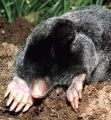|
Mole Description:
The mole is about the size of a chipmunk and weighs about four ounces (100 grams). Its most distinctive feature is the adaptive, palm like, short front feet which are held in a hands-over-the-head position with the palms facing outward. The mole uses these to get through the soil in about the same way a person swims underwater. Except for the flexible, pig like snout, the head is featureless, appearing to be lacking a neck, eyes and ears. Although the mole can only detect light and dark with its eyes, its sense of hearing, touch and smell are acute. The velvety fur is characteristically slate-gray but often appears silvery on fleshly groomed moles and sooty-black on juveniles. A cinnamon-brown staining on the chin and along the middle of the belly is common on the adults, but this is usually is more pronounce in the males. The mole's nearly naked tail acts as an organ of touch which allows the animal to move backwards in its tunnels, although it can, thanks to a narrow hip girdle, perform a somersault in the burrow. Moles are carnivorous. Grub worms and earthworms constitute the bulk of their diet. The mole also preys on other soil-dwelling creatures such as beetles, spiders, centipedes, ant pupae and cutworms. In fact, a mole can harvest more than 140 grub worms and cutworms daily (many of which are destructive to your backyard plants). Moles may be found wherever the soil is sufficiently thick, pliable and adhesive enough to support a tunnel system and is adequately populated with wee beasties for food. Habits: Unfortunately, it is the mole's feeding activity that gives him a bad name. Even though he is a principal aerator and mixer of the soil, his earthen works can disfigure lawns and golf courses; when mice or other rodents use the mole's passages, plant seeds, roots and bulbs can be destroyed, too. The mole hills (mounds of loose dirt) and the heaved ridges (tunnels) are just tall enough to catch a lawnmower blade. This troublesome digging usually is the work of a single mole since this mammal is solitary throughout most of the year. In the spring, however, a mother and her litter of four can all be feeding in your backyard. If you get tired of stomping down mole hills, the proper use of a trap will usually take care of the problem. Choker and spear traps are the two principal types. The choker trap is less readily available and more difficult to use and handle. Although the spear trap usually impales the mole, it is readily available, easier to use, and if it is visited regularly, the moles that become impaled will not suffer for long. The spring devices in both traps are powerful; read the trap directions carefully and exercise caution to avoid injuries. Management: To be effective, a mole trap must be properly set across a major run--those tunnels that are used frequently. Generally, these lead from the nest to the different feeding areas. The day before setting the trap(s), stomp down all the runs so you can determine where the major runs are located. Major runs will probably be pushed back up the next day. Select a fairly straight two- or three-foot section of one of these major runs that has been pushed back up; with a single sharp blow with the heel of your shoe, stomp down on the middle of this to create an obstruction in the tunnel. The trap should be placed over this obstruction so that the mole will spring the trap as it repairs the tunnel. Set your trap according to the instructions included with it, and carefully trigger it a couple of times to see it is working properly. A good test to check whether you have a good trap location is to punch a small hole in the run on both sides of the trap with a stick. Moles do not like light and will plug holes in runs that light penetrates. Later, if the trap is not tripped but the holes are plugged, the animal has passed by but missed the trap. In that case, strike the burrow two or three times with your heel to collapse the new tunnel and reset the trap. If the trap is not sprung and the holes are not plugged after two days, you probably should move the trap to another location. When temperatures are cold or hot, moles spend most of their time in the deeper burrows. Therefore, you are most likely to be successful at trapping moles in the spring or fall. Although trapping is the most effective, least disruptive method to rid your yard of moles, there are others. Treating your yard with insect control products to kill the food source will discourage moles from staying around. |
